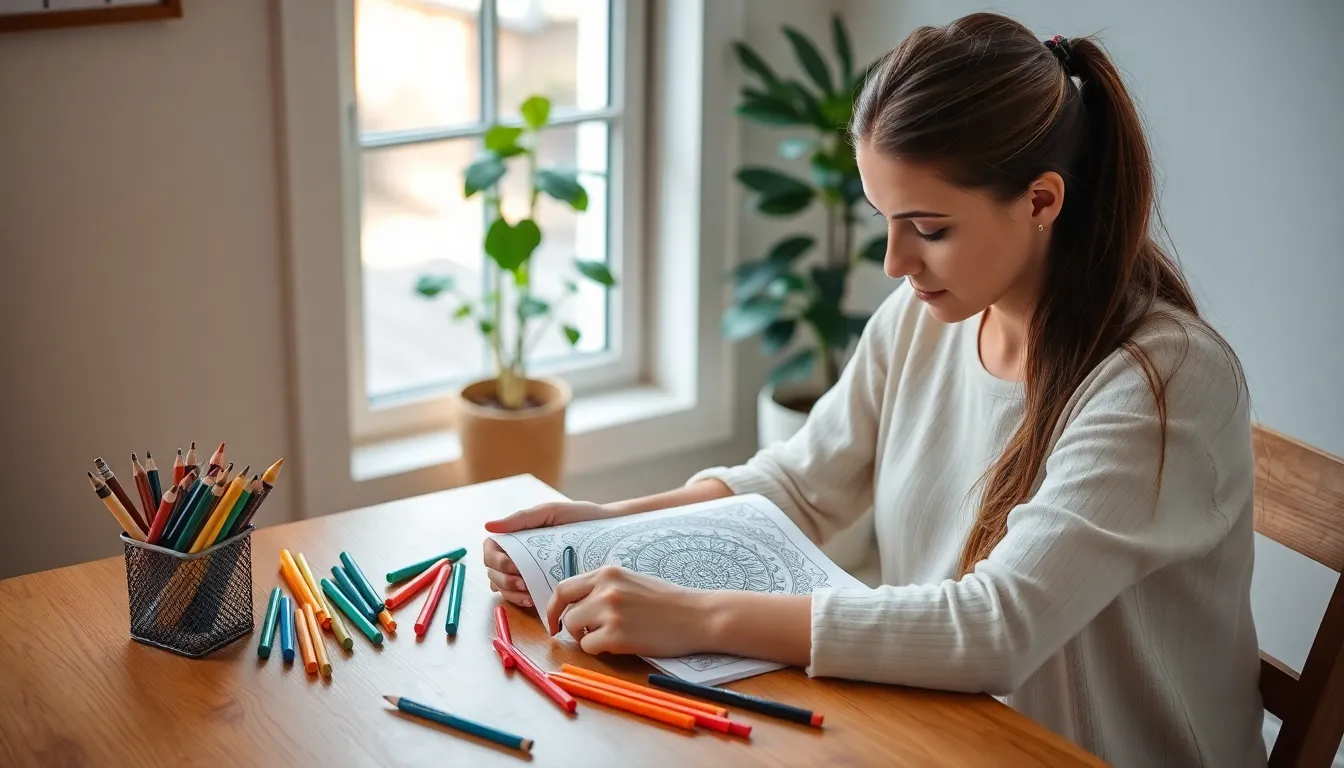Table of Contents
ToggleIn a world buzzing with distractions, it’s easy to feel overwhelmed. Enter mindful coloring, the unexpected hero of relaxation. Who knew that picking up a crayon could be the key to unlocking serenity? Forget about adulting for a moment and dive into the whimsical world of colors. It’s not just for kids anymore—adults are rediscovering the joy of coloring, and trust us, it’s not just an excuse to buy a box of fancy markers.
Mindful coloring isn’t just about filling in the lines; it’s about embracing the present moment. As they swirl colors together, folks find stress melting away faster than ice cream on a hot day. So grab those crayons and unleash your inner artist. Whether you’re a Picasso or a stick figure enthusiast, mindful coloring invites everyone to join the fun while reaping the benefits of mindfulness.
What Is Mindful Coloring?
Mindful coloring represents a focused approach to the art of coloring, emphasizing the importance of being present in the moment. This practice invites individuals to immerse themselves in an experience that combines creativity and relaxation. Engaging with colors and patterns fosters a deep sense of calm, allowing distractions to fade away.
Participants often choose intricate designs or simple patterns. These options cater to various preferences and skill levels. The act of coloring provides mental engagement, encourages concentration, and serves as a form of active meditation. As colored pencils fill the spaces, users often notice an enhanced ability to manage stress and anxiety.
Mindful coloring also encourages self-expression. People often find joy in selecting colors that resonate with their emotions or reflect their personalities. This freedom to choose empowers individuals, helping them cultivate a deeper connection with their inner selves.
Studies suggest that the repetitive motion of coloring can lower heart rates and reduce cortisol levels, promoting a sense of well-being. Engaging in this activity for even a short time frames a mindful break in a busy day. Many experts emphasize that regular practice of mindful coloring can streamlines the mind and sharpen overall focus.
Mindful coloring is an accessible and enjoyable way to incorporate mindfulness into daily routines. Individuals interested in enhancing their mental health can benefit, regardless of their artistic ability. The simple act of picking up a coloring tool can lead to meaningful and satisfying experiences.
Benefits of Mindful Coloring

Mindful coloring offers various benefits that enhance mental health and well-being. Engaging in this practice allows individuals to experience significant reductions in stress levels while promoting emotional balance.
Stress Reduction
Stress reduction remains a primary benefit of mindful coloring. Engaging in this creative activity fosters relaxation, facilitating a break from daily pressures. Numerous studies indicate that coloring can lower heart rates and decrease cortisol levels, the stress hormone. This simple act of choosing colors and filling in designs can provide a peaceful distraction, allowing the mind to unwind. Participants often report feeling calmer and more centered after spending time coloring. Regular practice of mindful coloring also contributes to an overall sense of tranquility and well-being, making it a valuable tool for stress management.
Enhanced Focus
Enhanced focus develops through the practice of mindful coloring. Concentrating on the intricate details of a design encourages individuals to immerse themselves fully in the present moment. This focused engagement improves attention spans, making it easier to tackle other tasks after coloring sessions. As participants navigate lines and shapes, they cultivate mindfulness, which translates into better focus in daily life. Research suggests that the rhythmic motions involved in coloring activate brain regions associated with concentration. Adopting mindful coloring as a routine can sharpen mental acuity and increase productivity in various settings.
Emotional Well-Being
Emotional well-being thrives through mindful coloring. Individuals often choose colors based on their moods, promoting self-expression and creativity. This reflective aspect of coloring allows for deeper emotional exploration and self-understanding. Numerous individuals find that their emotional states shift positively after engaging in this activity. Furthermore, coloring provides an accessible outlet for stress relief, helping to mitigate feelings of anxiety or overwhelm. As a result, regular coloring sessions not only enhance emotional health but also foster a sense of accomplishment and satisfaction, reinforcing overall well-being.
How to Get Started with Mindful Coloring
Mindful coloring can be a wonderful way to decompress and reconnect with one’s thoughts. Taking the first steps involves selecting suitable materials and finding a source of inspiration.
Choosing the Right Materials
Selecting coloring tools plays a critical role in the experience. Options include colored pencils, markers, or gel pens, each providing a unique coloring experience. Opt for high-quality tools that glide easily across the paper, enhancing enjoyment. Choosing thick, textured paper helps prevent bleed-through, ensuring vibrant colors remain true. Experimenting with different materials may reveal personal preferences, making the coloring experience even more fulfilling.
Finding Inspiration
Finding inspiration can significantly enhance the mindful coloring experience. Look for designs that spark interest, ranging from intricate mandalas to simple geometric patterns. Online platforms and books provide numerous options for every skill level. Engage with various themes to discover what resonates; nature, abstract art, or pop culture can offer fresh ideas. Personalizing the coloring space with calming elements like plants or soft lighting also encourages creativity and focus.
Techniques for Effective Mindful Coloring
Techniques enhance the mindful coloring experience, promoting relaxation and creativity. Two crucial elements to consider include color selection and mindful practices during the activity.
Color Selection
Choosing colors plays a vital role in emotional expression during coloring. Individuals often select colors that resonate with their feelings, whether bright hues evoke joy or softer tones promote calmness. Opting for a diverse palette encourages experimentation, allowing for personal interpretation and creativity. With colored pencils, markers, or gel pens, artists can explore unique combinations and gradients. Utilizing warm colors may inspire energy, while cooler shades can create a tranquil environment. Prioritizing color selection fosters deeper engagement and enriches the mindful coloring journey.
Mindful Practices While Coloring
Integrating mindful practices elevates the coloring experience beyond mere activity. Focusing on breath helps individuals maintain a calming rhythm as they color. Establishing a dedicated space for coloring enhances concentration and minimizes distractions, allowing for deeper immersion. Setting time limits can create a sense of urgency while encouraging individuals to enjoy the process fully. Embracing each stroke, participants should acknowledge their thoughts without judgment, fostering a non-critical mindset. Regularly practicing these mindful techniques cultivates a more enriching and fulfilling experience with each coloring session, enhancing overall engagement.
Mindful coloring serves as a refreshing escape from the chaos of daily life. By engaging in this simple yet profound activity, individuals can tap into their creativity while fostering a sense of calm. The benefits extend beyond relaxation, promoting emotional expression and improved focus.
As people incorporate mindful coloring into their routines, they discover a valuable tool for managing stress and enhancing overall well-being. Whether one opts for intricate designs or simple patterns, the key lies in embracing the process and being present. This practice not only nurtures the mind but also encourages a deeper connection to oneself, making it a worthwhile addition to anyone’s self-care toolkit.




